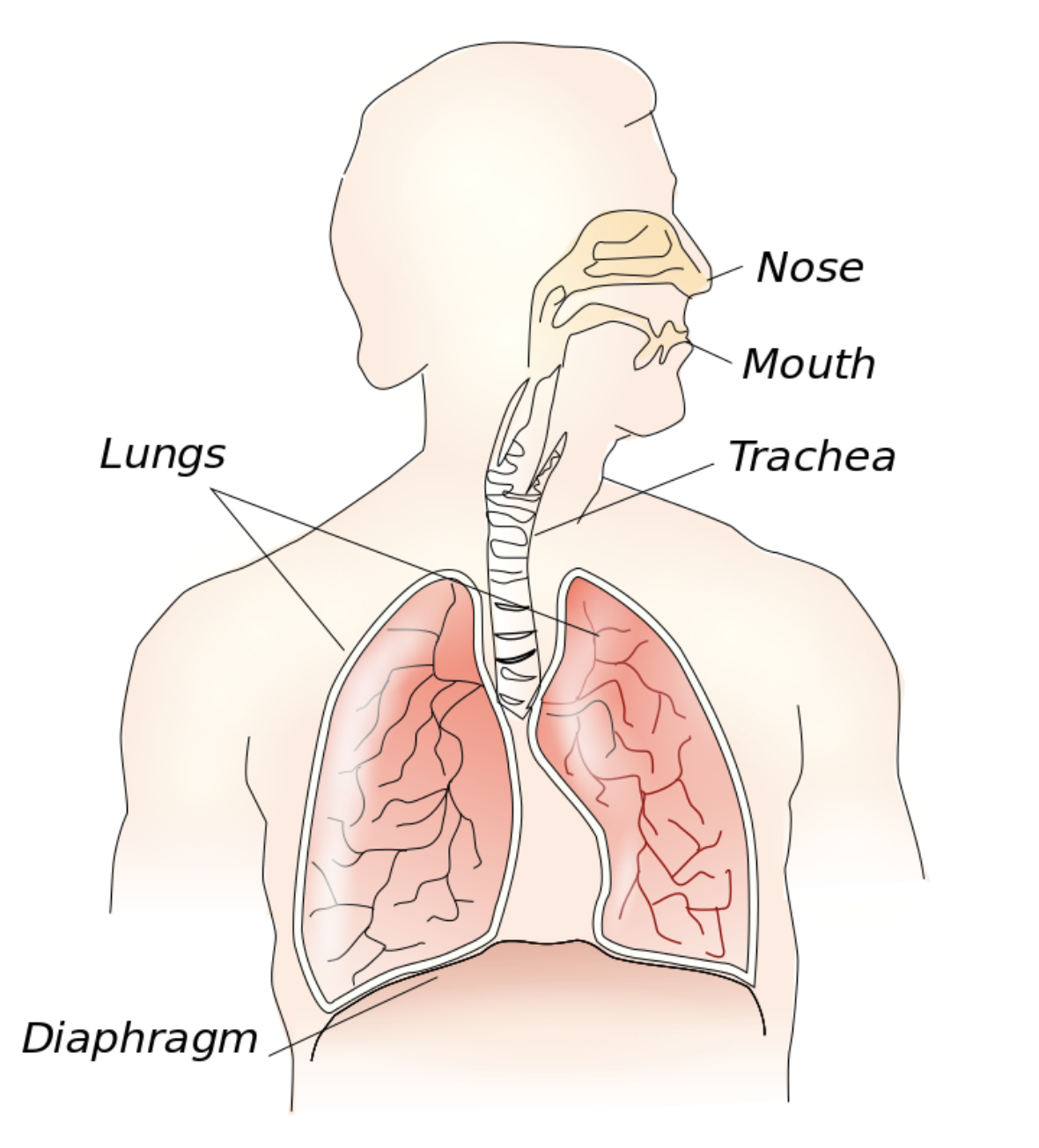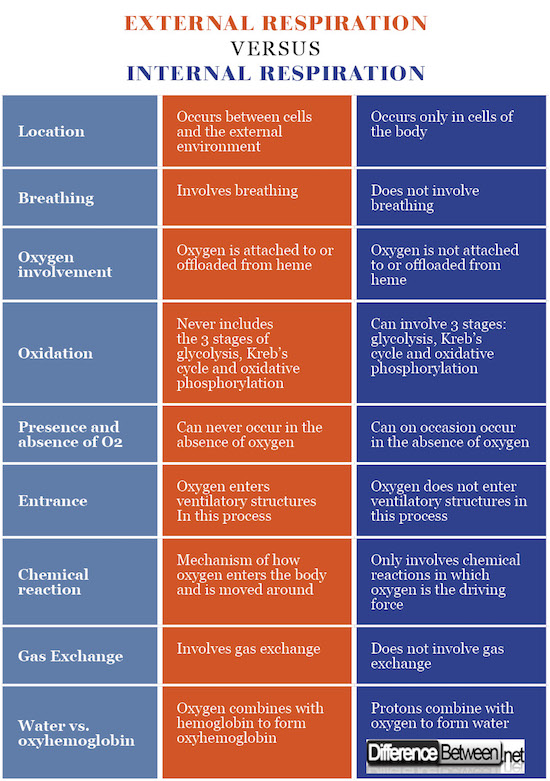Difference Between External Respiration and Internal Respiration
What is External Respiration?

External respiration describes respiration that occurs between the external environment and the cells of the body.
External respiration consists of two stages:
- Breathing
- Gas exchange
The first stage involves ventilation or breathing, which is the intake of oxygen into the body and expulsion of carbon dioxide out of the body.
The second stage involves the exchange of gases between the blood capillaries and the alveoli of the lungs. The alveoli are thin walled round shaped cells (or air sacs) that occur in groups within the lungs. There are several of these air sacs packed together to increase surface area for gas exchange.
Gases move between cells in external respiration. Oxygen that is inhaled diffuses from the alveoli into the blood of capillaries. There the oxygen attaches reversibly to the heme (iron) of the hemoglobin of the red blood cell.
Carbon dioxide which attaches to an amino acid in the blood offloads from the red blood cell in order to be exhaled from the body. The blood cells transport the gases around the body. This is how oxygenation of body cells is achieved and waste products removed.
Many animals do not have lungs for gas exchange. Animals such as fish that live in water have gills instead of lungs for instance, and some animals in water can also use the skin as a gas exchange surface.
What is important is that the gas exchange surface needs to be kept moist in order for gases to be exchanged. In terrestrial animals these surfaces are kept moist, for instance by production of mucus in the lungs.
Oxygen is needed for internal respiration to occur, thus external respiration is critical in keeping our cells alive. Very few organisms can continue to undergo cellular respiration in the absence of oxygen.

What is an Internal Respiration?
Internal respiration occurs within cells of the body and involves all body cells, not just cells of the lungs. It uses oxygen to break down molecules in order to release energy in the form of adenosine triphosphate (ATP). Internal respiration is often also called cellular respiration since it occurs within the cell.
Internal cellular respiration can occur in two forms:
- Aerobic respiration which requires oxygen
- Anaerobic respiration (also known as fermentation) which does not require oxygen
The cells of most living organisms cannot survive long periods of anaerobic respiration, and thus oxygen is needed. Aerobic respiration generates large amounts of energy as ATP while anaerobic respiration cannot produce very much energy (ATP).
Aerobic respiration involves three stages:
- Glycolysis (splitting of sugar) which occurs in the cytoplasm
- Kreb’s cycle which occurs in the matrix of the mitochondrion
- Oxidative phosphorylation which occurs across the membrane of the mitochondrion.
The oxygen is the final electron acceptor of what is known as the electron transport chain found in the last stage, oxidative phosphorylation, of aerobic cellular respiration. Oxygen provides a force to drive the transport of electrons down the chain. As electrons move across the membrane, ATP is formed from ADP.
Water and carbon dioxide are produced as waste products of internal cellular respiration. Water is formed when protons combine with oxygen at the end of the electron transport chain.
Difference between External Respiration and Internal Respiration
Location:
External respiration occurs between cells of the body and the external environment while internal respiration occurs within cells.
Breathing:
External respiration involves breathing, while internal respiration does not.
Involvement of Hemoglobin:
External respiration involves oxygen attaching to or offloading from the heme of hemoglobin. This is not an internal respiration process.
Oxidation:
Internal respiration involves three stages: glycolysis, Krebs cycle and oxidative phosphorylation; this is not the case for external respiration.
Involvement of Oxygen:
Internal respiration can sometimes occur without oxygen, this is not the case with external respiration.
Entrance:
External respiration involves oxygen first entering the ventilatory structures such as lungs or gills; this is not the case with internal respiration.
Chemical Reaction:
External respiration is the mechanism of how oxygen physically enters the body and is moved around, while internal respiration is only a process of chemical reactions which involves oxygen as a driving force.
Gas Exchange:
External respiration involves gas exchange, internal respiration does not.
Involvement of Water vs. Oxyhemoglobin:
Internal respiration involves protons eventually combining with oxygen to form water while in external respiration oxygen combines with hemoglobin to form oxyhemoglobin.
Table comparing External vs. Internal Respiration

Summary of External vs. Internal Respiration:
- External respiration involves breathing during which oxygen is inhaled and carbon dioxide is exhaled.
- External respiration also involves gas exchange, the exchange of oxygen and carbon dioxide between body cells and blood cells.
- Internal respiration is the respiration that occurs within a cell. There are two types: aerobic respiration which requires oxygen and anaerobic respiration which does not require oxygen.
- Internal respiration is known as cellular respiration and is the chemical process by which glucose is broken down and energy (ATP) produced.
- Most living organisms need aerobic respiration in order to produce enough energy to survive, and thus require the oxygen that enters the body by external respiration.
- Both external and internal respiration are linked with external respiration bringing in the oxygen needed for internal respiration. External respiration removes the carbon dioxide produced during internal respiration.
- Difference Between Rumination and Regurgitation - June 13, 2024
- Difference Between Pyelectasis and Hydronephrosis - June 4, 2024
- Difference Between Cellulitis and Erysipelas - June 1, 2024
Search DifferenceBetween.net :
2 Comments
Leave a Response
References :
[0]Image credit: https://commons.wikimedia.org/wiki/File:2316_Inspiration_and_Expiration.jpg
[1]Image credit: https://en.wikipedia.org/wiki/Muscles_of_respiration#/media/File:Respiratory_system.svg
[2]Dorit, Robert L, Warren F. Walker, and Robert D. Barnes. Invertebrate Zoology. Philadelphia: Saunders College Publishing, 1991. Print.
[3]Kilgour, O.F.G. Mastering Biology. London: MacMillan Press, 1982. Print.
[4]Rye, Connie, Robert Wise, Vladimir Jurukovski, Jean DeSaix, Jung Choi, and Yael Avissar. Biology. Houston: Rice University, 2017. Print

very nice explaination……mastttt
Really good
Excellent!!!
Really good explanation